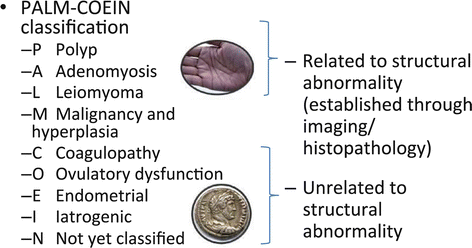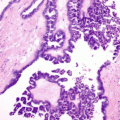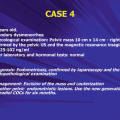Questions
Answer from women with normal MBL
How often do you change your sanitary pad/tampon during the peak flow days?
Change pads/tampons every 3 h
How many pads/tampons do you use over a single menstrual period?
Use fewer than 21 pads/tampons per cycle
Do you need to change the tampon/pad during the night?
Seldom need to change a pad/tampon during the night
How large are any clots that are passed?
Have clots less than 1 in. in diameter
Has a medical adviser told you that you are anemic?
Not be anemic
9.3 Causes of Heavy Menstrual Bleeding and Diagnostic Classification
The FIGO Committee on Menstrual Disorders developed a descriptive terminology to characterize the frequency, regularity, duration, and heaviness of flow of a woman’s menses14 and the PALM-COEIN classification for causes of bleeding, based on discrete structural (PALM: polyps, adenomyosis, leiomyomas, and malignancy/hyperplasia) and nonstructural causes (COEIN: coagulopathy, ovulatory dysfunction, endometrial dysfunction, iatrogenic, and not yet classified).


Most women with a complaint of HMB do not have any structural or histologically identifiable abnormalities.
In the new PALM-COEIN classification, the classification will be abnormal uterine bleeding due to endometrial dysfunction (AUB-E).
9.4 Treatment Options
There are two basic therapeutic approaches.
The surgical approach comprises endometrial ablation/resection and hysterectomy. There is an approximative bleeding reduction of 87 and 100 %, respectively. The proportion of patients having less than 80 ml blood loss per cycle is 100 % in both procedures.
Other clinical properties of these methods are summarized in the table.
Properties of surgical methods in HMB treatment
Ablation/resection | Hysterectomy | |
|---|---|---|
Patient satisfaction | 83 %a | 93 %b |
Level of evidence for clinical efficacy | Several randomized and observational studies | Several randomized and observational studies |
Validity and reliability of measured outcome | High: efficacy reliably assessed by amenorrhea rates and number of repeated interventions | High: definite procedure |
Safety (potential ADRs as mentioned in the NICE guidelines) | Vaginal discharge, increased period pain or cramping (even if no further bleeding), perforation (but very rare with second-generation techniques) | Infection, damage to other abdominal organs, urinary dysfunction (frequent passing of urine and incontinence), thrombosis, death (rare) |
The medical approach includes the following drugs:
Combined oral contraceptives
Oral/depot progestogen
Tranexamic acid
Non-steroidal anti-inflammatory drugs (NSAIDs)
Progestogen-releasing intrauterine systems
9.4.1 Combined Hormonal Contraceptives
There are eight studies (involving 430 patients) available that assess the impact of combined hormonal contraceptives in the treatment of HMB, of which six were randomized controlled trials, five assessed combined oral contraceptives and one assessed the use of vaginal ring.
The medium bleeding reduction is about 43 %.
The advantage of this treatment is that it provides additional contraception if desired by the woman.
The treatment is under the control of the woman and in general well tolerated.
Commonly reported adverse effects of combined hormonal contraception include abdominal cramp/pain, acne, breast tenderness/discomfort, depression/mood changes, diarrhea, headache, nausea/vomiting, and weight gain.
Stay updated, free articles. Join our Telegram channel

Full access? Get Clinical Tree






